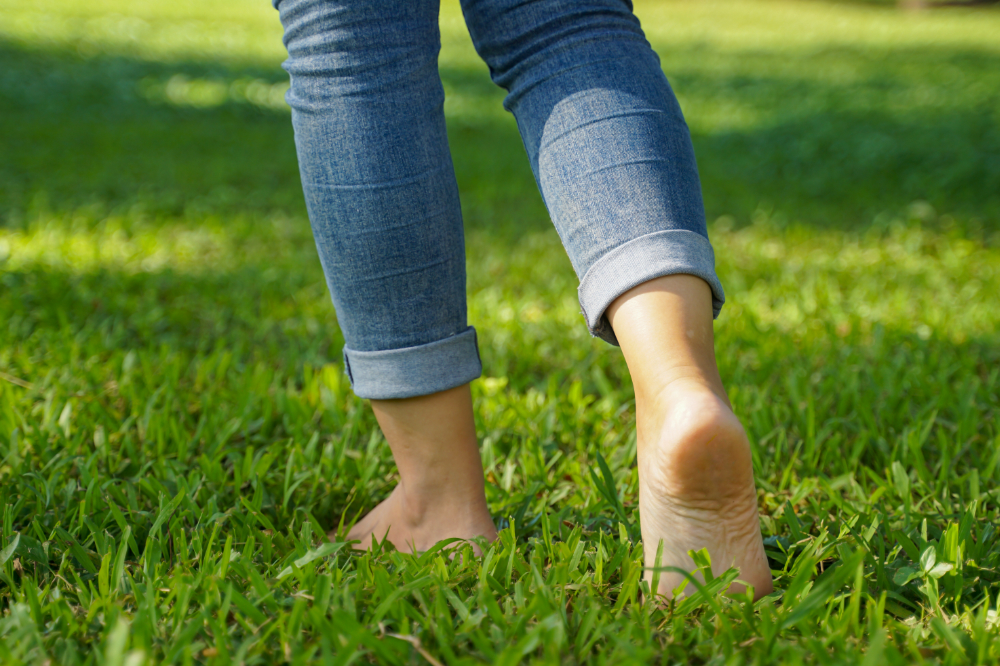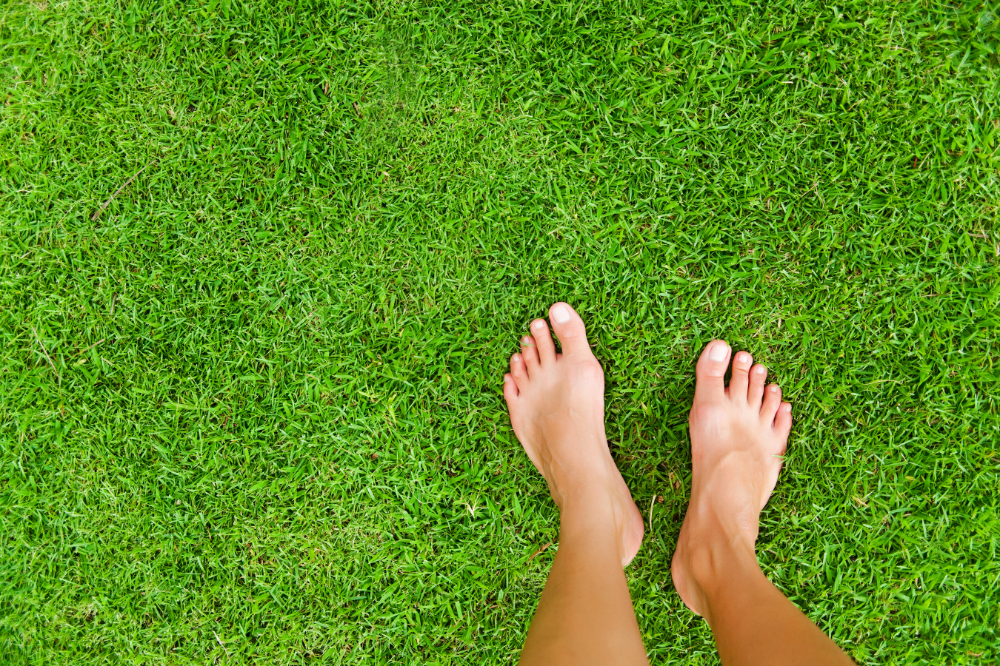Grounding With the Earth
The concept of “grounding” or “earthing” suggests that people can connect with the Earth by physically touching it, typically through their feet, and that this connection has potential health benefits. Proponents of grounding claim that direct contact with the Earth’s surface, such as walking barefoot on grass, soil, sand, or even immersing oneself in natural bodies of water, can lead to a variety of positive effects on health and well-being. These claimed benefits include:
Grounding Can Reduce Inflammation:
Some proponents of grounding suggest that contact with the Earth’s surface can help reduce inflammation in the body, possibly due to the exchange of electrons between the Earth and the body.
Grounding Can Improve Sleep:
It is suggested that grounding may help improve sleep quality and reduce insomnia by regulating circadian rhythms and reducing stress.
Grounding Can Reduce Pain:
Some people claim that grounding can alleviate chronic pain conditions by balancing the body’s electrical charge and reducing pain signals.
Grounding Can Reduce Stress:
Grounding is said to have a calming effect on the nervous system, potentially reducing stress, anxiety, and depression.
Enhanced Well-Being From Grounding:
Advocates argue that grounding can lead to an overall sense of well-being and vitality.
Regain Balance in the Body
The earth can bring your body back to a natural balance in your body

While many individuals report positive experiences with grounding, it’s important to note that scientific research on this topic is limited, and the evidence is largely anecdotal. Some studies have suggested potential benefits, but more rigorous research is needed to establish a clear causal relationship between grounding and these claimed health effects.
Critics argue that some of the perceived benefits of grounding may be due to a placebo effect or other confounding factors. Additionally, the mechanisms behind grounding, such as the exchange of electrons between the Earth and the body, are not fully understood, and more research is needed to validate the claims made by proponents of grounding.
In summary, while the idea of grounding or earthing is intriguing and has gained popularity in certain wellness communities, it remains a topic of ongoing scientific investigation. If you are interested in exploring grounding practices, it’s essential to do so with an open mind and a critical eye, and to consult with healthcare professionals for guidance on its potential benefits and risks, especially if you have underlying health conditions.

What is Happening During Grounding?
Electrons are subatomic particles that are a fundamental component of atoms. They have a negative electric charge and are found orbiting the nucleus of an atom. Electrons play a crucial role in the behavior of atoms and the way matter interacts with electricity and magnetism.
When we talk about electrons in the context of “earthing” or “grounding,” the idea is that by coming into contact with the Earth’s surface, electrons can flow between the Earth and the human body. Proponents of earthing or grounding suggest that this electron exchange may have potential health benefits, such as reducing inflammation and promoting relaxation. However, scientific research on these claims is limited and inconclusive.
In the scientific context, electrons in the Earth’s crust are part of the natural composition of matter. The Earth’s surface is made up of various elements, including metals and minerals, which contain atoms with electrons. Electrons in the Earth’s crust are involved in chemical reactions, electrical conductivity, and the behavior of materials.
In summary, electrons are subatomic particles found in the atoms of matter, including the Earth’s crust. While electrons are essential for the functioning of atoms and molecules, the concept of electrons in the Earth’s surface in the context of health benefits, as suggested by some proponents of earthing or grounding, is a subject of ongoing research and debate. There does exist some scientific evidence to support this and there are anecdotal examples of the benefits of these electrons affecting persons bodies.

How Do We Ground Ourselves?
Earthing, also known as grounding, is the practice of connecting with the Earth’s surface to potentially benefit from its electrical charge and electron exchange. Here’s how you can practice earthing:
Find a Suitable Location:
Look for a natural outdoor area with direct contact to the Earth’s surface. Ideal surfaces include soil, grass, sand, or unpainted concrete.
t’s best to choose a location away from potential sources of contamination or pollution.
Going Barefoot is the Best:
To practice earthing, you need direct skin contact with the Earth. This means walking barefoot or using conductive footwear like sandals with leather soles that allow electrons to flow between the Earth and your body.
Spend Time Outdoors:
Engage in outdoor activities that allow you to connect with the Earth’s surface. You can walk, sit, lie down, or even practice yoga or meditation while grounded.
Stay Grounded for a Sufficient Time:
It’s generally recommended to spend at least 20-30 minutes practicing earthing to potentially experience its benefits.
The longer you stay grounded, the more electrons your body can absorb, so consider making it a regular practice.
Please Practice Safety While Grounding:
Be mindful of your surroundings and potential hazards, such as sharp objects, thorns, or insects, while walking barefoot.
Avoid areas with broken glass, chemicals, or other pollutants, and dog parks.
Time and Your Location:
Earthing can be done at any time of the day or year, but many people prefer to practice it in the morning or evening when the temperature is more comfortable.
The practice can be done in various outdoor settings, such as a park, garden, or beach.
I have heard that to reduce jet lag one should go outside in the new location and go barefoot to connect to the earth.
Be Mindful and Relax to Ground Properly:
While practicing earthing, take the opportunity to relax, meditate, or simply be present in the moment. Connect with the natural world around you.
Hydrate and Protect Yourself:
Ensure you are well-hydrated, especially in warm weather, and protect yourself from excessive sun exposure with sunscreen or shade. For your body to work properly it must have sufficient hydration.
Grounding Mats
Some people purchase a grounding mat to place under their 100% cotton bedsheets so they benefit from grounding during the night or they use sheets with metal threads running through to transfer the electrons to them while they sleep. Other people purchase a mat for their bare feet to rest upon during the day while they are working at their desks.
It’s important to note that while many individuals report positive experiences with earthing, scientific research on this topic is limited, and the health benefits are not widely accepted in the scientific community. The potential benefits of earthing, if any, may vary from person to person.
If you are considering earthing for health reasons, it’s advisable to consult with healthcare professionals, especially if you have underlying health conditions. Additionally, while earthing can be a simple and enjoyable practice, always be mindful of your safety and the cleanliness of the surface you are in contact with to minimize the risk of contamination or injury.
The video below is about the mission of Clint Ober to share the information of earthing. See www.earthing.com




